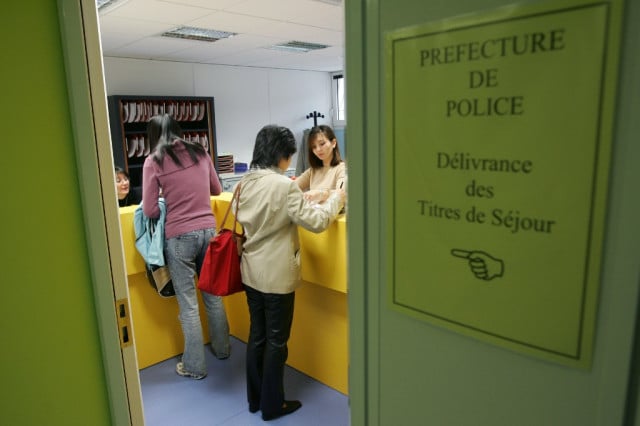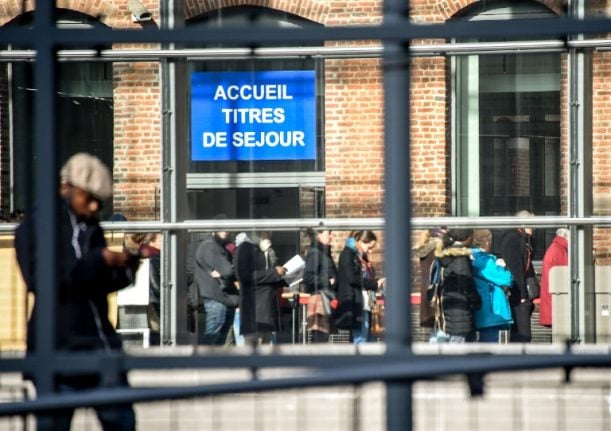French Prime Minister Edouard Philippe has announced that a new online system will be launched in October to allow British people who are already resident in France to apply for a carte de séjour (residency permit) – as will be necessary after Brexit.
Although details are scant at this stage, many people welcomed the idea, particularly if it does away with the current system, which has resulted in a postcode lottery.
READ ALSO LATEST The ultimate no-deal checklist for Britons living in France

Currently applications for the carte de séjour residency permit are processed by the local préfecture where the applicant lives (apart from in Paris where they are processed by the Préfecture de Police).
And readers of The Local have reported huge variations in different areas – some places like the Dordogne have stopped accepting new applications altogether, some are still processing, some operate an appointments-only system while in other places you have to just turn up and queue.
Problems have been particularly acute in places where there is a large British population and many local préfectures have been simply overwhelmed with the number of applications.
It’s worth pointing out the local services have received no extra resources and precious little guidance in dealing with residency applications from British people – who have not previously needed to register in France.
The chaos in Westminster, which has resulted in Britain’s departure from the EU being delayed twice already, has understandably persuaded some local authorities in France to decide to wait until they know when and under what circumstances the UK leaves the bloc.
Kalba Meadows from citizens rights group Remain in France Together (RIFT) gave the news of the new online platform a cautious welcome.
“As ever, the devil is in the detail,” she said. “We understand that although applications will be made on a central online platform they will still be processed by individual préfectures, many of which will struggle to meet the demand without extra resources.”
Lottery
RIFT has been gathering testimonies from British residents who have gone through the process – from those who were successful and have the all-important card to those who were turned away or who have been waiting months for their documents to be processed.
Here is a look at how the situation varies depending on where you live in France.
Nice, Alpes-Maritimes
Claire Phillips, a RIFT Administrator from the campaign group Europeans United said:
“The prefecture in Nice, covering the 06 Alpes-Maritimes department, responded to early criticism and has made some improvements in its processes.
“When UK citizens started making their carte de séjour applications en masse in early summer 2018, they had to start queuing outside the préfecture as early as possible in the morning.
“The advice was to arrive by at least 6am. Tickets were given out in the queue once in the préfecture and if you weren’t in the first 200, you were turned away. The offices do not open until 9am and we had reports of people spending six or seven hours in total to obtain their récépissé and a further two hours to collect the card some weeks later.
“In early spring 2019 the préfecture introduced a rendezvous system. Applicants are required to obtain the appointment by attending the prefecture. Reports say that this takes around 1 hour/1.5 hours.
“Currently the appointments are being given seven or eight weeks later. All appointments are given for 9am and the applicants need to queue but not from as early as before, as you are guaranteed an opportunity to present your dossier. Some are still arriving early, but recent reports say you can now arrive around 8am and be seen by 11am. You are still required to attend at a later date to collect the card.
“Like many other prefectures, Nice has asked for documents not shown on their official list. The local Remain in France Together (RIFT) Alpes-Maritimes group on Facebook, provides useful and specific information for applicants of the process in Nice and the documents required.”
Toulouse, Haute-Garonne
Julie Hall, another RIFT Administrator, had this to say about the situation in the departément of Haute-Garonne.
“The level of communication, clear requirements and appointment system make it relatively painless in a very busy préfecture. Toulouse préfecture has a named, English-speaking contact for carte de séjour applications from British residents, who responds quickly to queries by email.
“There is a clear list of paperwork required, and an appointment system that worked well. The appointment was quick and efficient.
“There’s no appointment for collections, and they warn of a long wait. All staff from the door to the fonctionnaires were helpful and gave directions to anyone who looked lost. Parking is very difficult, and potentially very expensive.”

For some Carcassonne’s bureaucracy has proved as impregnable as its city walls. Photo: AFP
Carcassonne, Aude
RIFT’s Justine Wallington and Leigh Chandler had a very different story from Aude.
Leigh Chandler said: “The Aude department has many UK Citizens living in our around the Carcassonne area, so the prefecture at Carcassonne had been particularly busy processing cartes de séjour to its UK residents.
“Until early July 2019, this process was efficient at least for the applicant. An email requesting an appointment would result in a three month wait.
“During that period the applicant would pull the necessary information together and arrive at the prefecture before the allotted time. A numbered ticket would be issued upon arrival, and the wait to see a clerk would not be too long. Couples could go in together which reduced any stress or nervousness they might have had and also helped as many original documents applied to each of the couple.
“The administration team at Carcassonne was always courteous, efficient and took time to update the information onto their computer system. Fingerprints were taken and a recipisee issued. Applicants were advised to wait for an SMS message to inform them that their cards were ready for collection. The average wait for the cards was weeks.”
But then Carcassonne closed for new appointments and only accepted postal applications.
Justine Wallington said: “Their standard email reply to queries from British people reads: “Dear Sir or Madam, With your current status as a European national, you do not need a residence permit to reside and work on French national territory. Your situation may be reviewed, when the time comes, according to the agreements related to Brexit.
Consequently, the prefecture’s foreigners’ office will not be able to receive you, even if you have already obtained an appointment.”

In some areas a ‘black market’ in appointments has sprung up
Other areas
In the three years since the Brexit vote, The Local has received a huge number of comments from people about the different situations where they live.
It has been a frustrating time as often the official advice people were given was not the same as what local authorities were saying and some local authorities were significantly better than others at dealing with the previously unprecedented situation of people who are still currently EU citizens applying for a carte de séjour.
There has also been a big variation reported on the documentation needed, with some people being asked to supply virtually every piece of paperwork relating to their life in France while others were only asked for basics like passports, work contracts and proof of address.
People have also reported a big difference in the interview process at the préfectures, with some being grilled on every minor detail while in other places officials simply processed their documents.
Reader Sue Halliday told us: “I applied in November last year, and I still have no indication that all is in order at the préfecture in Tulle, Correze.
“I’ve tried emailing them but get only the ‘this is not the correct department’ reply. The office is in a very difficult location, the single disabled space is always occupied. I am a blue badge holder as I have MS and cannot cope with the steepness of the streets. I understand that some cards have been issued so obviously I am concerned.”
One woman who is applying in the Essonne département in the greater Paris Île-de-France region posted a video online showing the huge queue already in place outside the prefecture in Evry when she turned up at 6am. Many people appeared to have spent the night sleeping on the pavement in order to secure their place in the queue.
In other places there have been reports of a ‘black market’ developing for appointments for the carte de séjour application.
Although appointments are free, in some places they are so hard to secure that websites and Facebook groups have sprung up offering people the chance to purchase appointments. Prosecutors in Paris are believed to be investigating some sites.
However there were plenty of people reporting a smooth and simple process. Christopher Williams, who lives in Vienne, said the whole process took 10 minutes at the sous-préfecture, having received an appointment within a week of calling.



 Please whitelist us to continue reading.
Please whitelist us to continue reading.
Member comments